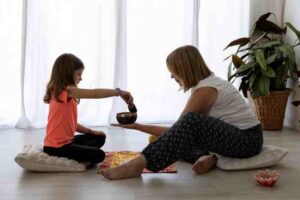As 7 Little Children’s Meditation Games for Teaching Stress Management takes center stage, this opening passage beckons readers with entertaining interactive style into a world crafted with good knowledge, ensuring a reading experience that is both absorbing and distinctly original.
Let’s dive into the world of children’s meditation games designed to teach stress management in a fun and engaging way. From breathing exercises to sensory scavenger hunts, these activities are sure to captivate young minds and help them unwind in a playful manner.
Introduction to Children’s Meditation Games: 7 Little Children’s Meditation Games For Teaching Stress Management

Teaching stress management to children is crucial in today’s fast-paced world where they face various challenges and pressures. By equipping children with the tools to handle stress effectively, we are helping them build resilience and emotional well-being.
Using meditation games for stress relief in kids offers a fun and engaging way to introduce mindfulness practices. These games not only help children relax and calm their minds but also teach them valuable skills that they can use throughout their lives.
Children’s meditation is a powerful tool for developing mindful relationships. By practicing 30 Little Children’s Meditation Tips for Developing Mindful Relationships , kids can learn to communicate better, listen actively, and cultivate empathy towards others. These techniques help them build strong, positive connections with their peers and family members.
Benefits of Children’s Meditation Games for Stress Relief
- Meditation games provide a safe space for children to explore their emotions and thoughts, promoting self-awareness and self-regulation.
- Through these games, children learn how to focus their attention, improve concentration, and enhance their problem-solving skills.
- Playing meditation games can reduce anxiety, improve mood, and increase overall well-being in children.
- These games also help children develop empathy, compassion, and kindness towards themselves and others.
Role of Play and Fun Activities in Stress Management
- Engaging in play and fun activities is essential for children’s mental health as it promotes relaxation, creativity, and social connection.
- By incorporating play into stress management techniques, children are more likely to participate willingly and enjoy the process.
- Playful activities help children release pent-up energy, reduce tension, and promote a sense of joy and happiness.
- Through play, children can express themselves freely, build confidence, and develop coping mechanisms for dealing with stress.
Game 1: Breathing Buddies

Breathing Buddies is a fun and interactive game designed to teach children about stress management through deep breathing techniques. This game helps kids learn how to calm their minds and bodies when feeling overwhelmed or anxious.
Quality sleep is essential for children’s growth and development. By practicing 7 Easy Little Children’s Meditation Techniques for Better Sleep , kids can relax their minds and bodies before bedtime, leading to a peaceful and restful night’s sleep. These techniques improve their sleep patterns and overall well-being.
Significance of Deep Breathing
- Deep breathing is essential in reducing stress and anxiety by activating the body’s relaxation response.
- It helps children focus on their breath, promoting mindfulness and awareness of their emotions.
- Deep breathing can lower heart rate, decrease blood pressure, and alleviate tension in the body.
Tips for Introducing the Game, 7 Little Children’s Meditation Games for Teaching Stress Management
- Start by explaining to children the importance of deep breathing in managing stress and staying calm.
- Encourage kids to find a comfortable sitting position and place a stuffed animal or toy on their belly.
- Guide them to take slow, deep breaths, watching how their “Breathing Buddy” rises and falls with each inhale and exhale.
- Make the game engaging by incorporating storytelling or visualization techniques to enhance the experience.
Game 2: Mindful Coloring
Mindful coloring is a calming activity that involves focusing on coloring within the lines and paying attention to the colors being used. This practice encourages children to be present in the moment, which can help reduce stress and anxiety.Engaging in coloring activities can help children focus and relax by promoting mindfulness and concentration. As children concentrate on filling in the shapes with colors, their minds are diverted from any worries or distractions, allowing them to enter a state of relaxation.
Building focus is a valuable skill that children can develop through meditation. With 30 Best Little Children’s Meditation Exercises for Building Focus , kids can enhance their concentration, attention span, and cognitive abilities. These exercises help them stay present and engaged in various tasks, leading to improved academic performance and overall productivity.
Themes and Variations of Mindful Coloring
- Animal Kingdom: Children can color in various animals like lions, elephants, and birds, promoting a sense of connection with nature.
- Underwater Adventures: Coloring underwater scenes with fish, corals, and sea creatures can evoke a sense of calmness and tranquility.
- Fantasy Worlds: Imaginary landscapes with unicorns, fairies, and dragons can spark creativity and provide an escape from everyday stressors.
Game 3: Guided Imagery

Guided imagery is a powerful technique used in stress management for children. It involves the use of imagination to create a calming and peaceful mental image, helping children relax and reduce feelings of anxiety or stress.
Process of Guided Imagery for Stress Management
- Start by guiding the children to find a comfortable position and close their eyes.
- Encourage deep breathing to help them relax and focus.
- Describe a peaceful scene or scenario for them to picture in their minds, such as a sunny beach or a quiet forest.
- Guide them through the details of the scene, incorporating senses like touch, smell, and sound.
- Allow them to immerse themselves in this visualization, helping them feel calm and at ease.
- Finally, slowly bring them back to the present moment by asking them to take a few deep breaths.
Examples of Scenarios for Guided Imagery
- Imagining floating on a cloud and feeling weightless.
- Picturing a garden full of colorful flowers and feeling the warmth of the sun on their skin.
- Visualizing a peaceful stream flowing gently through a lush forest.
Positive Effects of Visualization Techniques
- Helps children relax and reduce stress and anxiety.
- Encourages creativity and imagination.
- Improves focus and concentration.
- Promotes emotional well-being and a sense of inner peace.
Game 4: Gratitude Stones
Gratitude stones are small, smooth stones that children can decorate or personalize with symbols, colors, or words representing things they are grateful for in their lives. These stones serve as tangible reminders of the positive aspects of their life that they can hold onto during moments of stress or anxiety.
Fostering empathy in children is crucial for creating a compassionate society. Through 10 Little Children’s Meditation Techniques to Foster Empathy , kids can learn to understand and share the feelings of others. These exercises encourage kindness, tolerance, and respect towards everyone around them.
Concept of Gratitude Stones
- Gratitude stones help children focus on the good things in their lives, fostering a sense of appreciation and positivity.
- Decorating the stones allows children to express their creativity and individuality while reflecting on the things that bring them joy.
- By holding onto or looking at their gratitude stones, children can instantly shift their focus from negative thoughts to positive ones, promoting emotional well-being.
Incorporating Gratitude Stones into a Stress Management Game
- Introduce the concept of gratitude stones during a mindfulness session and encourage children to create their own stones using art supplies.
- Include a game where children take turns sharing what they are grateful for while holding onto their gratitude stones, promoting a sense of community and connection.
- Incorporate the use of gratitude stones as a calming tool during relaxation exercises, allowing children to hold onto them while practicing deep breathing or guided imagery.
Benefits of Practicing Gratitude
- Practicing gratitude helps children develop a positive mindset and outlook on life, leading to increased resilience against stress and adversity.
- Regularly reflecting on what they are grateful for can improve children’s overall well-being and mental health, reducing the impact of negative emotions.
- Building a habit of gratitude can teach children to cope with challenges in a more positive way, enhancing their ability to navigate stress and difficult situations.
Game 5: Sensory Scavenger Hunt
Introducing children to stress management skills through a sensory scavenger hunt can be a fun and interactive way to help them connect with their senses and learn how to relax.
Teaching children relaxation techniques through meditation is essential for their well-being. With 25 Little Children’s Meditation Routines for Teaching Relaxation , kids can unwind, reduce stress, and improve their sleep quality. These practices promote a sense of calmness and teach them how to manage their emotions effectively.
Examples of Sensory Items for the Scavenger Hunt:
- A smooth rock to touch and feel
- A scented flower or herb to smell
- A piece of fruit to taste
- A soft fabric to feel
- A small bell to listen to
Connection Between Sensory Experiences and Relaxation:
Engaging in sensory experiences can help children focus on the present moment, which in turn can reduce stress and anxiety. By incorporating different sensory items into the scavenger hunt, children can learn to pay attention to their surroundings, regulate their emotions, and find moments of calm amidst the chaos of everyday life.
Game 6: Progressive Muscle Relaxation

Progressive Muscle Relaxation (PMR) is a technique used to help children release tension and reduce anxiety by systematically tensing and then relaxing different muscle groups in the body. This game is a great way to teach kids how to recognize and manage physical stress.
Technique of Progressive Muscle Relaxation
- Start by having the child find a comfortable and quiet place to sit or lie down.
- Explain to the child that you will be tensing and then relaxing different muscle groups in the body.
- Begin with the feet and instruct the child to tense the muscles in their feet for a few seconds, then release and relax.
- Move on to the calves, thighs, abdomen, arms, neck, and face, repeating the tensing and relaxing process for each muscle group.
- Encourage the child to focus on the sensations of tension and relaxation in each muscle group.
Benefits of Progressive Muscle Relaxation
- Helps children develop body awareness and recognize physical signs of stress.
- Teaches kids how to relax their bodies and release tension on their own.
- Reduces anxiety and promotes a sense of calm and relaxation.
- Can improve sleep quality and overall well-being in children.
Game 7: Nature Sound Walk

Taking children on a nature sound walk can be a wonderful way to introduce them to the calming effects of nature and help them manage stress effectively.
Concept of Nature Sound Walk
A nature sound walk involves taking a leisurely stroll in a natural setting while actively listening to the sounds of nature around you. This activity encourages children to focus on the present moment, connect with their surroundings, and experience a sense of tranquility.
- Examples of Nature Sounds:
-Birds chirping
-Rustling leaves
-Flowing water
-Crickets chirping
-Wind blowing through trees
Importance of Connecting with Nature
Engaging with nature has been shown to have numerous benefits for mental well-being, especially in children. By spending time outdoors and listening to nature sounds, kids can reduce stress levels, improve concentration, and enhance their overall mood. Encouraging a connection with nature from a young age can instill a lifelong appreciation for the environment and provide valuable coping mechanisms for dealing with stress.
In conclusion, these 7 Little Children’s Meditation Games offer a creative and enjoyable approach to teaching stress management to kids. By incorporating these activities into their daily routine, children can develop valuable coping skills and learn to navigate stress in a healthy way. So, gather your little ones and embark on a journey towards relaxation and well-being through these fun and effective games.




